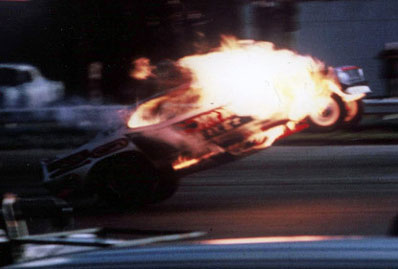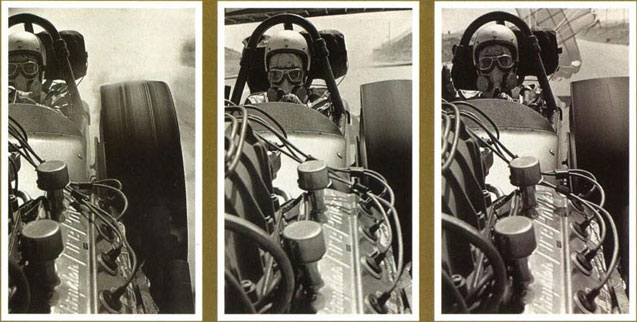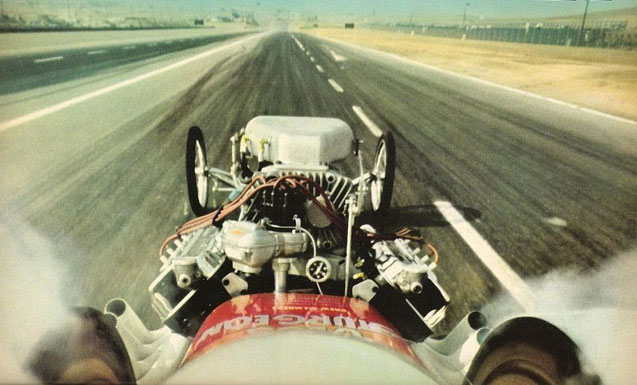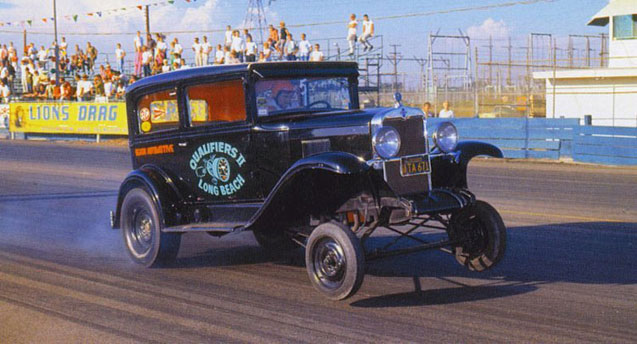

Fun with Fotos revisited
It's probably every writer's dream to come up with something so cool or so original that it is handed down from generation to generation or becomes so widely distributed to the masses that it takes on a life of its own. Whether it's an oft-quoted philosophy or truism ("A penny saved is a penny earned") or a few lines from an entire speech ("Four score andÌýseven years ago" from Abe Lincoln's Gettysburg Address), to imagine that your sagely penned words would develop a life all of their own is heady stuff. Yeah, sometimes we writers dream small.
Sure, Ben and Abe had a 200-plus-year head start on me, though I doubt IÌýcould have come up with anything as sage as their words. Although I've been at this drag writing business for three decades, I can’t really say that I've created any new words or phrases to add to drag racing's already significant lexicon or single-handedly did something as cool as give a racer his or her famous nickname, but this column has definitely expanded my audience as I find some of the columns reprinted, verbatim, on other Web sites and message boards (that's a real no-no, for the record) or links to this site (much better).
Most recently, a mass e-mailing of one of my columns from last year, a column originally called Fun with Photos, has been making the rounds of nostalgia-themed message boards and mailing lists, many of which I am on. I find it rather amusing when I receive these e-mails with new introductions added to the column or replacing my original, and also a bit flattering. The photos aren't even from our files-- I harvested them from The H.A.M.B. bulletin board -- and added whatÌýI thought were interesting captions to them and of interest to the readers of this column and even those not as intimately familiar with our history.
It was interesting to see heroes like Jim Nicoll among those passing it on to his e-mail friends (me included), but the real kick came Sunday night when I received it again from a well-meaning reader who said, "Thought I would forward this e-mail to you. A friend sent it to me, and there is some pretty cool stuff. You may have a lot of this, but in case you don't, here goes."
That's pretty funny when you think about it.
You can find my original posting , though the formatting there is a little goofy because it was done on the old NHRA.com template that allowed for wider photos, and the photos stick out into the ads now. Clearly, there is a great interest in these photos and the sentiments I attached to them, so I find it worth reprinting. Those who didn't see it the first time through should enjoy it, and those who have or are looking at the e-mails will now have the stories and details that accompany the pics.
In the interest of a better presentation and reclaiming the work, I redid the layout a little bit and added to it because, in the true nature of this column, I received a lot of follow-up information about many of the pics that I ran in subsequent columns. My original caption will be in bold and the additional info (if any) in italic.
There's a lotÌýto take in, so I'll split this into two halves; look for the second part Friday.
Enjoy!
 |
Back in the day, anything was possible. How about an Offy with a side-mounted blower on Ed Donovan's dragster?
Paul Schwan of Cincinnati dropped me a line about Ed Donovan's side-mounted blower, noting, "The 6-71 blower that was originally used was indeed mounted on the side of a 6-71 Detroit Diesel, or before it was Detroit, it was a GM diesel, or affectionately known as a 'Jimmy Diesel.'
"In either a right- or left-hand 6-71, the side of the engine on which the blower was mounted determined either rotation or direction of the engine; therefore, that mount on the Offy was closer to 'stock' than most people realized."
One thing you can safely say about Ed Donovan is that the man was never boring or without a million thoughts racing through his mind.
 |
Nothing says drag racing like way too big of an engine stuffed into too little car; reminds me of the models I used to imagineer as a kid.
Fred Fischbach had no problem ID-ing the owner of the blown Austin Healey as his old friend Norm Cowdrey. "This is from the mid- to late '60s," he wrote. "Norm had the chassis built in San Fernando by a sprint car chassis builder by the name of Rip Erickson. It was powered by a blown small-block, but I don't remember the cubes. The car was an instant NHRA record setter, and as you can see by the picture, a real crowd-pleaser. It was painted at a body shop in the southwest corner of Tony Nancy's complex where Tony lived and had his upholstery shop. The car was a beautiful lime green with large gold metal flake that had been shot up in the air and allowed to settle on it, then clear-coated. The whole package was totally awesome.
"Sometimes when there was no race for Norm to go to, he would unbolt the blower and put it on his Corvette – underdriven, of course -- and we'd go tooling around the Valley; no big deal today, but then -- big deal.Too much fun."
Bill Holland added, "Cowdrey normally did well in one of the eliminator categories at San Fernando Dragway, where the photo was taken. Norm went on to campaign the Blue Fox Camaro Funny Car. He later was involved in a few TAFC deals, one of which was driven to a Wally win at Las Vegas by Rod Alexander ("Wild Bill's" son). Today, Norm plays with vintage road race cars. I chatted with him a few months ago at the races on Coronado Island, where he ran well with an ex-Paul Newman McKee Can-Am car."
 Rear slicks churning, front tires grabbing air, and an acrobatic flagman. |  Uhhh, dude? I don't think you asked for a big enough head start. |
The great shot of the go-kart racing the dragster was from Tampa Int'l Dragway and featured "T.V. Tommy" Ivo in the digger against the Turbonique rocket-engine-equipped kart. Both were there making exhibition runs, and someone got the great idea to pair them.
"I was all for it," recalled Ivo, "as I running much better than him and also because I used to do all kinds of things like that all the time. I would give stockers big head starts and run them down on the big end – or even bicycles, anything to take the ho-hum out of single runs -- but I would always make sure we put a good enough spread on the handicap to make sure I didn't get beat by mistake! How bad would that be, getting beat by a bicycle? Although this incident ended up to be even worse than that.Ìý
 |
"The rocket engine had a heart attack before we could have the race, so the guy with the kart still really wanted to get a picture with me racing him. Soooooooo, he suggested to just set him on the starting line next to me and get the picture when I took off. It wasn't a movie, so who would know if he were running or not? 'OK, that will work,' I said! But then once again, old Cecil B. De Ivo had to not leave well enough alone. Attempting to make a good idea better (as I always do), I suggested that they put the kart out about 25 feet or so; therefore, I could get up a good plume of smoke behind me to make the picture more dramatic. Wrong!! Here's the shot they were 'supposed' to get!
"I was a victim of my own stupidity, it would seem (again), BUT -- and here comes that 'but' again -- I was right; it did make a great shot, didn't it?"
 |
A wheelstander with everything but the kitchen sink.
Being able to ID a car is one thing, but being able to figure out at which track a photo was taken always requires some skill. Bill Carrell was "99.9 percent sure" that the Shower Power photo was taken at Thompson Drag Raceway in Thompson, Ohio, because of "the trees and their proximity to the track; the signage with roads identified in that area, specifically Ridge Road and Mayfield; I worked there and can tell a shot of that track from almost any angle; and where else but Ohio?"
Dawn Mazi-Hovsepian, Ohio's secondmost famous female Ohioan (behind The Pretenders' Chrissie Hynde and probably just ahead of Rona Veney) not only confirmed for me that it was taken at Thompson but also provided the year (1970) and the photographer (Charles Gilchrist). Said Dawn, "Gilchrist notes: 'The engine, a stout fuel-injected small-block Chevy, was turned around in the chassis and ran through a transfer case to the differential. The driver (Randy Davis) sat in the fiberglass tub (no water). This bathtub was quick, made full passes on the rear wheels at ease, and people loved it.' "
 |
Who said snakes can't fly? Prudhomme gets air in the lights in Seattle.
Al Kean, who shared his Seattle memories here not long ago, gets credit for this memorable shot of Don Prudhomme's Hot Wheels 'Cuda on fire and flying through the lights in Seattle at the second annual Hot Wheels Northwest National Open in Seattle in 1971. Prudhomme was racing Dave Condit in the L.A. Hooker Maverick in the final race of the day.
"I was watching everything through my camera’s viewfinder," wrote Kean. "The cars staged and launched. I was following the cars, and I thought I saw flames coming out of 'the Snake’s' windows as he neared the finish line. I remember thinking that it must just be glare off something – he couldn’t really be on fire, could he? I kept following the cars and clicked the shutter when they crossed the finish line. I then took the camera away from my face and looked downtrack to see Prudhomme’s car, with NO body on it, still in a wheelstand. It was at least 300 feet after the finish line before the car’s front wheels returned to earth.
"I had no idea what I had gotten in the photo. I had to wait several days for the color slides to get developed after we got home. It was pretty exciting to finally see the photo that I had taken. It was also exciting getting all the attention afterwards. The photo was published in Hot Rod magazine, Funny Car Pictorial, SIR programs, etc. Then track manager Bill Donor gave me a photo pass the next year, etc. The photo has also been mentioned in TV shows, over SIR’s PA, etc."
 |
Hard to believe that today's Top Fuelers evolved from this; from its whitewall tires to its Rat Fink-like shifter placement, I really dig this car.
Bob Post, author of High Performance, the unofficial bible of drag racing historians everywhere, said he believes this is Bill Martin of Palatka, Fla., shown running on the beach in Jacksonville, Fla., in 1953. "One of three slingshots I know of that pre-dated [Mickey Thompson's]," he noted. "Martin later became quite a well-known boat designer."
In looking at this picture, reader Cliff Morgan added that the body was probably one of the many that came from a fuel tank from an airplane. "Lots of guys used those tanks to create cars for the dry lakes after World War II, both front- and rear-engined versions, and some found their way to the drags. This car used the front section, and I can see the bottom of the car under the engine. Interesting design, and the car looked 'high tech' for its time, probably 1953-54."
 |
So you still think that Don Garlits invented the rear-engine dragster, do ya?
Ìý
 |
Donnie and Gene Bowman's flathead-powered Vineland Villain wasn't pretty, but it sure looked crude. Back then, functionality trumped almost everything.
Ìý
 |
I love this shot, taken in the pits at Lions. No, not the neat old flip-top panel wagon -- the lady, dressed in skirt and heels. Priceless.
Steve Gibbs had the ID on this great old photo. "This is the gasser of Dale (he) and Al (her) Kersh, of Modjeska Canyon, Calif. Both are now gone. They were fixtures at SoCal tracks for many years, competing in various brackets, and were truly great people. The interesting thing is that Al was never -- EVER -- dressed any differently. She always looked like she just came from an upscale social event -- classy and in heels."
Byron Stack of Gasser Madness confirmed that this is the Kersh Family A/Gasser. "Memory tells me it was powered by a Mopar wedge motor with homebuilt injection," he wrote. "It was a very cool piece and fun to watch."
 |
Again, it's the people who make this shot. The clown, second from left, doing his "Take the picture already" pose and the other guy still slipping on (or off?) his coat, who's clearly not ready for the shot. And that dragster? Not much traction in those rear meats.
 |
Kinda funny, too, but for a different reason is Surfers pilot Mike Sorokin almost having his helmet sucked off at speed (center).
 |
And speaking of in-car cameras, I just love this shot from Jess Sturgeon's car.
Steve Justice says that the great in-car camera shot was done at Riverside Raceway.
 (Above) This is a great shot, too, taken from the cockpit of one of Scotty Fenn's legendary Chassis Research chassis that revolutionized the sport. I took some Photoshop liberties with the original to blur the background as the El Camino tow vehicle was a distraction. Love that steering wheel and big ol' brake handle. (Below) This is Fenn's workshop. That's Fenn at far left overseeing work on some of his K-88 and TE-448 chassis. |
 |
 |
Another vintage chassis on this cool twin. Always amazing to me to see how primitive the early driver-protection devices were.
Neal Larson of Walla Walla, Wash., worked with early drag racing hero Jack Moss from Amarillo, Texas, so he knew all about this car, the famed Two Much entry.
"The picture was taken around 1961 or 1962," he wrote. "The car's last race was in Hobbs, N.M. We lost one of the engines, so we pulled one out and made a run with it, but the throttle stuck and rolled over; all was well with Jack, but the dragster was a total mess. The roll cage did its job.
"Jack was a member of the Barons Racing team from Amarillo. Find a Hot Rod magazine from September 1957 and look and see the first Two Much and the rest of the team."
 |
OK, if you don't like this photo, you can hardly consider yourself a drag fan. Classic Lions stuff.
OK, friends, that's all for today. I'll have Part 2 Friday, which is convenient for me because by that time I'll be ankle-deep in the Finals. If you just can't wait for Part 2, you can always revisit the original posting Ìýand find the column where a lot of the follow-up comments I've added originated .




















































